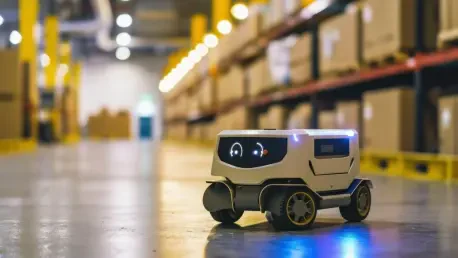Setting the Stage for Retail Transformation
In the fast-paced world of retail, where precision and speed are critical to success, inventory management remains a persistent challenge, costing businesses billions annually in lost sales and inefficiencies due to errors. The retail sector is at a critical juncture, grappling with labor shortages, rising operational costs, and the demand for seamless customer experiences. Automation has emerged as a pivotal solution, promising to bridge these gaps by streamlining processes that have long relied on manual intervention. This report delves into how two innovative companies are leading the charge in transforming retail operations through cutting-edge technology.
The current landscape of retail reflects a dynamic shift toward digital and automated systems. With e-commerce continuing to dominate consumer preferences, brick-and-mortar stores must adapt by optimizing backend operations to stay competitive. Technologies like artificial intelligence and robotics are no longer futuristic concepts but essential tools for enhancing efficiency, reducing human error, and meeting heightened consumer expectations. This sets the stage for a deeper exploration of groundbreaking partnerships driving this change.
The Retail Industry and the Rise of Automation
The retail industry today faces mounting pressure to maintain accurate inventory amidst fluctuating demand and supply chain disruptions. Manual stocktaking processes often lead to discrepancies, resulting in overstocking or stockouts that frustrate customers and erode profits. As a response, automation has gained traction, offering a way to minimize errors and improve operational agility in an environment where every second counts.
Key players in the automation space are leveraging advanced technologies such as AI-driven analytics and robotic systems to redefine how retailers operate. From smart shelves that alert staff to low stock to drones scanning warehouse aisles, these innovations underscore the importance of efficiency in maintaining a competitive edge. The integration of such tools not only cuts costs but also frees up human resources for more customer-centric tasks, marking a significant evolution in retail workflows.
This trend toward automation is not merely a passing phase but a fundamental restructuring of retail operations. With global retail sales projected to grow steadily over the next few years, the adoption of robotic and AI solutions is expected to accelerate, driven by the need for scalability and precision. Companies that embrace these technologies are poised to lead the market, setting new benchmarks for operational excellence.
NomadGo and Richtech Partnership: A Game-Changing Collaboration
Innovative Technology Behind the Partnership
At the heart of retail’s technological revolution lies the strategic alliance between NomadGo, a pioneer in inventory AI, and Richtech Robotics, a Nevada-based expert in AI-driven service robots. Their collaboration has birthed a fully autonomous inventory robot by merging NomadGo’s Inventory AI, powered by Spatial Vision technology, with Richtech’s two-armed mobile robot, Dex. This synergy aims to overhaul the labor-intensive process of inventory handling into a seamless, error-free operation.
NomadGo’s AI leverages on-device 3D spatial intelligence, computer vision, and augmented reality to generate a real-time 3D digital twin of retail shelves, ensuring pinpoint accuracy in stock counts down to the millimeter, even in challenging spaces. Paired with Dex, which navigates dynamic environments using built-in cameras and operates via an iPad or iPhone, the system autonomously maps surroundings for safe movement. Together, they create a closed-loop inventory framework that handles everything from counting stock to restocking shelves based on precise spatial data.
This integration represents a leap forward in automation by combining cognitive intelligence with physical execution. The system not only identifies low inventory levels but also triggers automatic replenishment and verifies delivery conditions, ensuring items are placed correctly. Such end-to-end functionality marks a significant departure from traditional methods, promising a future where inventory management operates with minimal human oversight.
Impact and Market Potential
The transformative potential of this partnership is already evident in NomadGo’s proven track record, with its Inventory AI deployed across over 11,000 Starbucks stores worldwide. This large-scale implementation has delivered near-perfect visibility into store operations, enhancing supply chain transparency and ensuring consistent product availability. Such success highlights the scalability and effectiveness of the technology in high-demand retail settings.
Looking beyond individual deployments, the collaboration holds immense promise for broader adoption across diverse retail and warehouse environments. Industry forecasts suggest that the market for autonomous solutions could see substantial growth from this year through 2027, fueled by the demand for efficiency and accuracy in inventory management. The combined expertise of NomadGo and Richtech positions their solution as a frontrunner in meeting these needs, potentially capturing a significant share of this expanding market.
Moreover, the ripple effect of this technology could redefine operational standards across sectors. As businesses witness the tangible benefits of reduced errors and labor costs, the incentive to invest in similar autonomous systems will likely intensify. This partnership serves as a blueprint for how integrated AI and robotics can address complex challenges, paving the way for widespread industry transformation.
Challenges in Adopting Autonomous Inventory Systems
Implementing AI and robotics in retail is not without hurdles, with high initial costs posing a significant barrier for many businesses, particularly smaller retailers with limited budgets. The financial outlay for acquiring and installing advanced systems like autonomous robots can be daunting, often requiring substantial upfront investment before tangible returns are realized. This economic challenge can slow adoption rates, even when long-term benefits are clear.
Beyond costs, integration complexities present another obstacle, as existing retail infrastructures may not be readily compatible with cutting-edge technologies. Retrofitting stores or warehouses to accommodate robots and AI systems often involves overhauling legacy systems, which can disrupt operations during the transition. Additionally, workforce adaptation remains a concern, as employees may require retraining to interact with or oversee automated processes, potentially leading to resistance or skill gaps.
To mitigate these issues, phased rollouts offer a practical approach, allowing businesses to implement automation incrementally while managing costs and minimizing disruption. Comprehensive training programs can also ease the transition for staff, ensuring they are equipped to collaborate with robotic systems. Furthermore, detailed cost-benefit analyses can help justify investments by projecting long-term savings and efficiency gains, encouraging more retailers to embrace this transformative technology.
Regulatory and Compliance Considerations in Retail Automation
Navigating the regulatory landscape is a critical aspect of deploying AI and robotics in retail, where data privacy stands as a paramount concern. Autonomous systems often collect and process vast amounts of data, including customer and inventory information, necessitating strict adherence to regulations like GDPR or CCPA to protect sensitive details. Non-compliance can result in hefty fines and reputational damage, underscoring the need for robust data security measures.
Workplace safety is another key regulatory focus, as robots like Dex operate in dynamic environments alongside human workers. Ensuring safe interactions requires compliance with standards that govern robotic design and operation, minimizing risks of accidents or injuries. Retailers must prioritize safety protocols and regular maintenance to meet these requirements, fostering a secure working environment amidst automation.
Additionally, technology standards for AI and robotics are evolving, with governing bodies establishing guidelines to ensure reliability and ethical use. Retailers adopting such systems must stay abreast of these developments to avoid legal pitfalls and maintain consumer trust. By aligning with regulatory frameworks, businesses can not only mitigate risks but also build confidence in the responsible deployment of automation, ensuring it benefits both operations and stakeholders.
The Future of Retail with AI and Robotics
Emerging trends in retail automation point to a future dominated by advanced technologies like machine vision, which enables real-time stock monitoring with unprecedented accuracy. This capability, combined with AI-driven analytics, allows for instantaneous decision-making, ensuring inventory levels are optimized without delay. Such advancements are set to redefine how retailers respond to demand fluctuations, enhancing agility in a competitive market.
Another significant trend is the move toward end-to-end process optimization, where every stage of retail operations—from procurement to customer delivery—is seamlessly integrated through automation. This holistic approach minimizes bottlenecks and maximizes efficiency, enabling businesses to focus on strategic growth rather than operational minutiae. As these systems become more sophisticated, their adoption is expected to surge, driven by the promise of streamlined workflows.
Global economic factors, including labor cost pressures and consumer demand for faster service, will further accelerate the shift to AI and robotics in retail. Technological innovation continues to lower barriers to entry, making automation accessible to a wider range of businesses. As these forces converge, inventory management is poised to become a fully autonomous domain, fundamentally altering the retail landscape with efficiency and precision at its core.
Reflecting on a Milestone in Retail Innovation
Looking back, the partnership between NomadGo and Richtech Robotics stood as a defining moment in the evolution of retail inventory management, showcasing how AI and robotics could synergize to address longstanding inefficiencies. Their collaboration demonstrated tangible outcomes, from enhanced accuracy in stocktaking to the liberation of human resources for customer-focused roles. This initiative proved that automation was not just a luxury but a necessity for staying competitive in a demanding market.
As a next step, stakeholders across the retail sector were encouraged to explore pilot programs for autonomous systems, leveraging the success of this partnership as a model for scalable implementation. Investment in training and infrastructure adaptation emerged as critical actions to ensure smooth integration of such technologies. By prioritizing these efforts, businesses could position themselves to capitalize on the growing wave of automation.
Moreover, the broader industry was prompted to advocate for clearer regulatory guidelines to support safe and ethical use of AI-driven solutions. Collaborative efforts between retailers, technology providers, and policymakers could foster an environment where innovation thrived without compromising security or trust. This forward-thinking approach offered a pathway to sustain the momentum of retail transformation, ensuring that automation continued to drive progress in meaningful ways.









